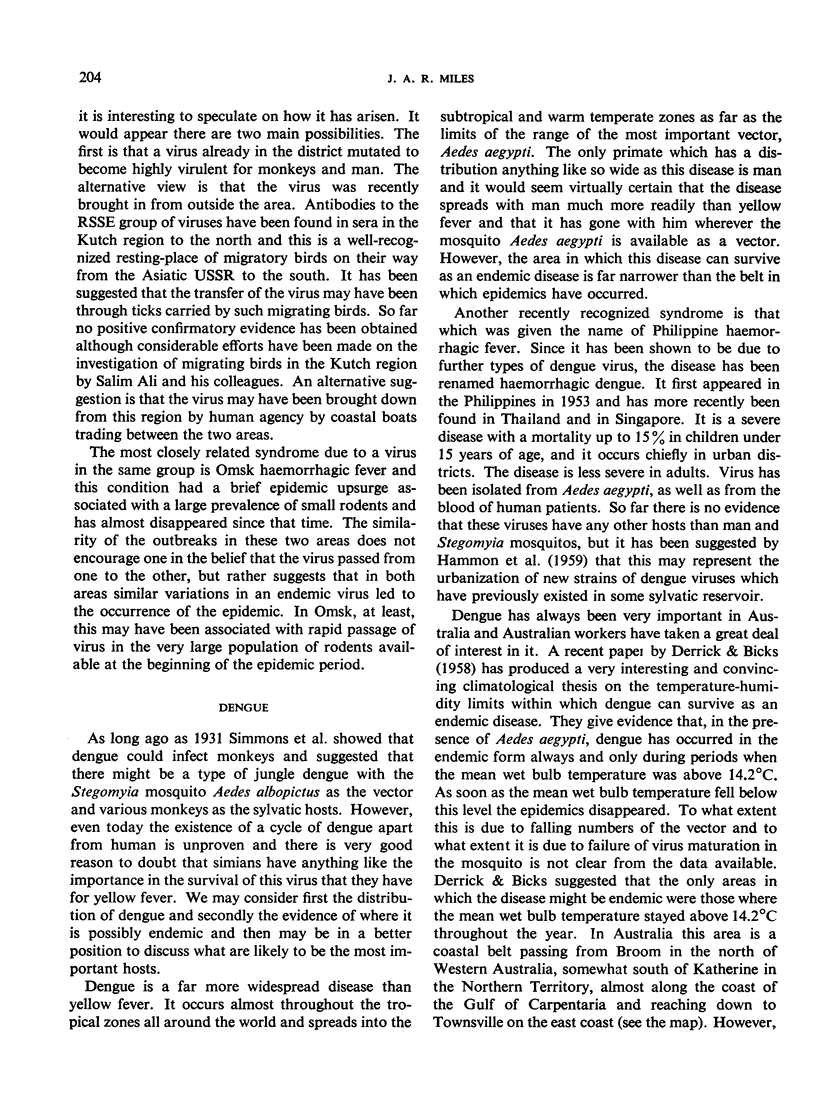Abstract
In recent years there has been an increasing awareness of the importance of arthropod-borne viruses in the Western Pacific region and in South-East Asia. This realization of the importance of these viruses as causes of human morbidity and mortality and of economic loss due to infection of domestic animals has led to studies attempting to elucidate the basic ecology of some of these viruses. The author reviews the extent of knowledge of the ecology of Japanese and Murray Valley encephalitis viruses and indicates possible mechanisms for the overwintering of the viruses based on experiments in which other viruses were mainly used. He discusses the limited available knowledge on the ecology of dengue and emphasizes the necessity of research on the possibility that this disease is a zoonosis. A brief discussion is also given of the haemorrhagic diseases which are found in these regions and a brief description of the state of knowledge on the ecology of Kyasanur Forest disease and epidemic nephroso-nephritis. A brief discussion is also included on the ecology of the tick-borne Russian spring-summer encephalitis.
Full text
PDF













Selected References
These references are in PubMed. This may not be the complete list of references from this article.
- ANDERSON S. G., DOBROTWORSKY N. V., STEVENSON W. J. Murray Valley encephalitis in the Murray Valley, 1956 and 1957. Med J Aust. 1958 Jul 5;45(1):15–17. doi: 10.5694/j.1326-5377.1958.tb60546.x. [DOI] [PubMed] [Google Scholar]
- AUDY J. R. The localization of disease with special reference to the zoonoses. Trans R Soc Trop Med Hyg. 1958 Jul;52(4):308–334. doi: 10.1016/0035-9203(58)90045-2. [DOI] [PubMed] [Google Scholar]
- BELLAMY R. E., REEVES W. C., SCRIVANI R. P. Relationships of mosquito vectors to winter survival of encephalitis viruses. II. Under experimental conditions. Am J Hyg. 1958 Jan;67(1):90–100. doi: 10.1093/oxfordjournals.aje.a119923. [DOI] [PubMed] [Google Scholar]
- BUESCHER E. L., SCHERER W. F., McCLURE H. E., MOYER J. T., ROSENBERG M. Z., YOSHII M., OKADA Y. Ecologic studies of Japanese encephalitis virus in Japan. IV. Avian infection. Am J Trop Med Hyg. 1959 Nov;8:678–688. doi: 10.4269/ajtmh.1959.8.678. [DOI] [PubMed] [Google Scholar]
- BUESCHER E. L., SCHERER W. F., ROSENBERG M. Z., GRESSER I., HARDY J. L., BULLOCK H. R. Ecologic studies of Japanese encephalitis virus in Japan. II. Mosquito infection. Am J Trop Med Hyg. 1959 Nov;8:651–664. doi: 10.4269/ajtmh.1959.8.651. [DOI] [PubMed] [Google Scholar]
- DERRICK E. H., BICKS V. A. The limiting temperature for the transmission of dengue. Australas Ann Med. 1958 May;7(2):102–107. doi: 10.1111/imj.1958.7.2.102. [DOI] [PubMed] [Google Scholar]
- DOHERTY R. L. Clinical and epidemiological observations on dengue fever in Queensland, 1954-1955. Med J Aust. 1957 Jun 1;44(22):753–756. [PubMed] [Google Scholar]
- HUANG C. H. Studies of virus factors as causes of inapparent infection in Japanese B encephalitis: virus strains, viraemia, stability to heat and infective dosage. Acta Virol. 1957 Jan-Mar;1(1):36–45. [PubMed] [Google Scholar]
- KISSLING R. E. Host relationship of the arthropod-borne encephalitides. Ann N Y Acad Sci. 1958 Jun 3;70(3):320–327. doi: 10.1111/j.1749-6632.1958.tb35391.x. [DOI] [PubMed] [Google Scholar]
- LA MOTTE L. C., Jr Japanese B encephalitis in bats during simulated hibernation. Am J Hyg. 1958 Jan;67(1):101–108. doi: 10.1093/oxfordjournals.aje.a119912. [DOI] [PubMed] [Google Scholar]
- MILES J. A. Arthropod-borne virus diseases of man. Australas Ann Med. 1961 Nov;10:317–326. doi: 10.1111/imj.1961.10.4.317. [DOI] [PubMed] [Google Scholar]
- MILES J. A., DANE D. M. S. Further observations relating to Murray Valley encephalitis in the northern territory of Australia. Med J Aust. 1956 Mar 10;43(10):389–393. [PubMed] [Google Scholar]
- MILES J. A. Observations on serum from aborigines in the northern territory of Australia. I. Antibodies against Lansing (type II) poliomyelitis virus. Med J Aust. 1953 Nov 21;2(21):773–778. [PubMed] [Google Scholar]
- O'CONNOR J. L., ROWAN L. C., LAWRENCE J. J. Relationships between the flying fox (genus Pteropus) and arthropod-borne fevers of North Queensland. Nature. 1955 Sep 3;176(4479):472–472. doi: 10.1038/176472a0. [DOI] [PubMed] [Google Scholar]
- REEVES W. C., BELLAMY R. E., SCRIVANI R. P. Relationships of mosquito vectors to winter survival of encephalitis viruses. I. Under natural conditions. Am J Hyg. 1958 Jan;67(1):78–89. doi: 10.1093/oxfordjournals.aje.a119922. [DOI] [PubMed] [Google Scholar]
- REEVES W. C., FRENCH E. L., MARKS E. N., KENT N. E. Murray Valley encephalitis: a survey of suspected mosquito vectors. Am J Trop Med Hyg. 1954 Jan;3(1):147–159. doi: 10.4269/ajtmh.1954.3.147. [DOI] [PubMed] [Google Scholar]
- REEVES W. C., HUTSON G. A., BELLAMY R. E., SCRIVANI R. P. Chronic latent infections of birds with Western equine encephalomyelitis virus. Proc Soc Exp Biol Med. 1958 Apr;97(4):733–736. doi: 10.3181/00379727-97-23862. [DOI] [PubMed] [Google Scholar]
- ROSEN L. Observations on the epidemilogy of dengue in Panama. Am J Hyg. 1958 Jul;68(1):45–58. doi: 10.1093/oxfordjournals.aje.a119948. [DOI] [PubMed] [Google Scholar]
- ROWAN L. C. Recent work on dengue fever. Med J Aust. 1957 Oct 12;44(15):530–533. doi: 10.5694/j.1326-5377.1957.tb60041.x. [DOI] [PubMed] [Google Scholar]
- SCHERER W. F., BUESCHER E. L., FLEMINGS M. B., NOGUCHI A., SCANLON J. Ecologic studies of Japanese encephalitis virus in Japan. III. Mosquito factors. Zootropism and vertical flight of Culex tritaeniorhynchus with observations on variations in collections from animal-baited traps in different habitats. Am J Trop Med Hyg. 1959 Nov;8:665–677. [PubMed] [Google Scholar]
- SCHERER W. F., BUESCHER E. L., McCLURE H. E. Ecologic studies of Japanese encephalitis virus in Japan. V. Avian factors. Am J Trop Med Hyg. 1959 Nov;8:689–697. doi: 10.4269/ajtmh.1959.8.689. [DOI] [PubMed] [Google Scholar]
- SCHERER W. F., MOYER J. T., IZUMI T., GRESSER I., McCOWN J. Ecologic studies of Japanese encephalitis virus in Japan. VI. Swine infection. Am J Trop Med Hyg. 1959 Nov;8:698–706. doi: 10.4269/ajtmh.1959.8.698. [DOI] [PubMed] [Google Scholar]
- SMORODINTSEV A. A. Tick-borne spring-summer encephalitis. Prog Med Virol. 1958;1:210–247. [PubMed] [Google Scholar]
- THOMAS L. A., EKLUND C. M., RUSH W. A. Susceptibility of garter snakes (Thamnophis spp.) to western equine encephalomyelitis virus. Proc Soc Exp Biol Med. 1958 Dec;99(3):698–700. doi: 10.3181/00379727-99-24468. [DOI] [PubMed] [Google Scholar]
- WORK T. H. Russian spring-summer virus in India: Kyasanur Forest disease. Prog Med Virol. 1958;1:248–279. [PubMed] [Google Scholar]


